 Swim
Comments: I need to learn to swim. Smack dab in the middle of my age group and the overall results. What would you do differently?: Trian.  Transition 1
Comments: crowded tent due to my average swim.  Bike
Comments: compact crank + 12-25 cassette was perfect.  Transition 2
 Run
 Post race
Event comments: I have re-written this race report in my head, and then on my laptop, so many times. Something inside of me is compelled to try to capture the personal significance of the event, but I’ve quickly realized that task is impossible for most ironman finishers. So many of us recognize the race as a stopping point on a journey that is much bigger than 140.6 miles, and I’ve come to realize that my ironman journey was very unique – just like everyone else’s. Capturing the significance of the event, then, would require a full autobiography that can’t be written yet… it’s incomplete and I’m not emotionally prepared, yet, to go there. I even tried to write it like a series of fragmented snapshots. While all the connections weren’t explicit, I had hoped that together – as a collage – they’d let you enter into my journey and understand something of how crossing that line was meaningful and transformational to me. In the end, I just wasn’t able to “go there” in detail in this race report, despite the desire to. My goal to race ironman lake placid 2009 ended in April of that year with a season-ending bike crash during a rainy, 48 degree training ride on unfamiliar roads. I had a 26mph make out session with a serrated metal bridge, awoke to people standing over me crying on their cell-phones and sirens in the distance, totaled my P2C before ever racing on it, brought home some titanium party favors, and to this day still pick an occasional speck of gravel out of my hip. The IM dream deferred made crossing the line at IMLP 2010 that much more special. Many people seem stunned by my results, given my background, for a debut ironman experience. And while I’m very happy with the time (and a little disappointed to come so close to Kona but be so far away), the finish time was one of the least significant parts of the race for me. Far more important were the wife and friends I love – wearing “Team Kaptur” custom tee-shirts and ringing cowbells screaming for me throughout the day – that I almost lost in divorce earlier this year. Just as satisfying was the journey from 237 to 171 (66 pounds) of the preceding nine months, so that I literally looked and felt like a different person (have you ever seen a recent picture of yourself and not recognized it because you are so used to seeing yourself as overweight?). Just as significant were the prayers of thanksgiving I offered throughout the day – for Physics and gyroscopic forces (on the wet Keene descent), for the beauty all around me, for ideal weather, for the grace that was so obviously manifest in so many areas, for the physical ability to even do the race, and for life-lessons and metaphors so abundant in a day of racing – to a higher power, faith in whom I had renounced earlier this year. Just as meaningful was the sense of community – the knowledge that at any moment, people all over the world were thinking of me, tracking me online, posting on my facebook, and watching the video to get a glimpse of me. A few pics of the journey to the start: Bridge I crashed on: 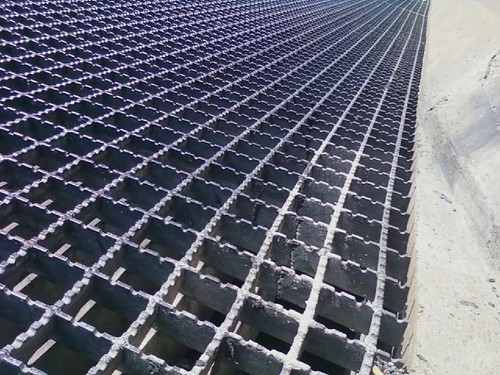 Lake Placid 2009: 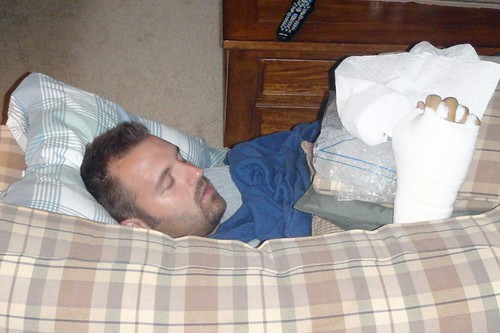 Here I am in November, 2009 at my 30th birthday party:  And in December, 2009, at the polar bear plunge: 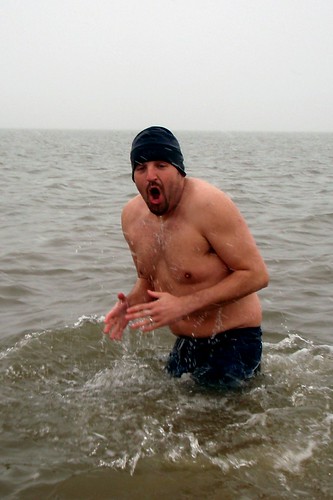 Here’s a “tapering” picture (you thought ironman was extreme???) from a week before the race... 66 pounds lighter:  And here I am, race ready, a few days later: 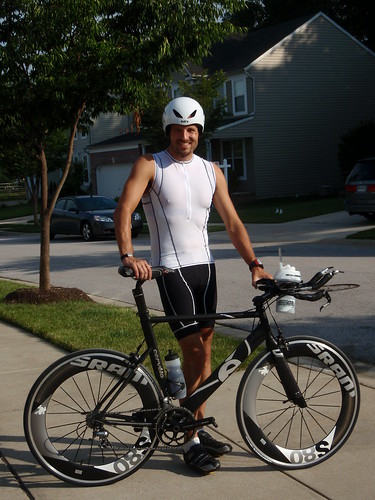 The Race If ever I was prepared for something, it was this race. I was relentless in my training, and had put up some impressive numbers in the months leading up to it. While my pool time was nothing to brag about, I felt completely ready to survive the swim in an average time and follow it up with a competitive bike and an even more competitive run. My 2010 totals through July were just over 1000 miles of running, just over 3200 miles of biking, and just under 100,000 yards of swimming. Earlier in the year I had crushed my 70.3 PR of 5:49:45 (well into the Clydesdale category) on a flat course with a 4:55:32 (40 pounds into my 66 pound journey) on a hilly/windy course. Race day was what I expected. I had read every race report I could find, both for Lake Placid specifically and for ironman in general. I felt like I had my nutrition strategy dialed in, all the logistics mentally rehearsed – all I needed to do was execute and my day would go great. But I couldn’t help but have a little anxiety as I waded into mirror lake. I had read far too many race reports about first-time iroman participants being humbled by the distance. I knew I had no idea what miles 130+ felt like. But I also had a plan to manage the things that were in my control, and to not worry about the things outside of it… to stick to the plan, yet be flexible and adaptable based on the reality of how my race was going throughout the day. I positioned myself for the swim about half-way across the starting line, and about 3 rows back. The swim went exactly as I expected… very crowded and rough for almost the entire first lap despite going pretty wide, and very uneventful for the second lap despite swimming within sight of the underwater rope. I have to say I really enjoyed the iroman swim, despite a few painful interactions with other racers. Particularly my second lap, despite that fact that I was undertrained on the swim, was just an enjoyable draft-fest. I was with people who were swimming my speed and felt like I wasn’t working at all. The sheer volume of people, plus the good visibility helped me to get a draft like I never have before in a race – it was easy even though I had never swum much more than a mile in training. If I had it to do over again, I would go out much harder for the first ¼ mile or so of the race, and hope to get pulled along by a faster group of people. T1 was where I really suffered for my average swim time. The change tent was PACKED and chaotic and there were very few seats available. I eventually found one and got down to business. I didn’t have much to do since I had worn my kit for the day under my wetsuit. Helmet, sunglasses, socks (rolled), race belt, and shoes all went on quickly. Cliff bars and part of my flat kit got stuffed into my jersey pockets as I ran out of the tent towards my bike. There was no volunteer to get my bike – again a consequence of finishing right in the thick of it in the swim – so I spent a few extra seconds running down the row to fetch it myself. My garmin was on my aero bars, and for the sake of battery life I did not turn it on until I got my bike. Hit the power button and then after I got down the hill and onto 73 and started to climb, I put it on my wrist so I could watch my HR. I can’t tell you I remember very much about the bike. I entered some sort of zone where I just kept my effort where it should be and focused on maintaining that effort no matter what. I remember the Keene descent on damp roads with a cross wind (both times I went down), and I have to tell you I do not enjoy this part of the course in the least. I’m shocked more people don’t crash. My max speed was 44.7mph, which is plenty fast enough for me. I spent very little time on the brakes, but quite a bit of time on the drops and sitting up. The people who went flying by me like I was standing still simply have a greater risk tolerance than I do. I also remember the climbs. Despite being 66 pounds lighter, I’m still no climber at 170+ pounds. On lap one, I spent all of the climbs passing hundreds of people (faster swimmers) like they were standing still. It was psychologically encouraging but also tempting to make ride too hard on lap two when I was riding with my peers (in terms of bike ability). I was happy with my pacing and effort for this ride. I did the first loop in 2:43:23 and the second loop in 2:44:06. Over and over again I reminded myself not to be a one loop wonder (thanks Fred), and on lap two I reminded myself not to be one of the people walking the marathon course talking about what a great ride they had. Even with that strategy, my relatively slow swim meant I passed approximately 800 people on the bike. I feel like I had a nearly perfect T2. I ditched my bike to a volunteer and grabbed my bag, and by the time I sat down in a FAR less crowded tent, had already opened my bag and dumped it on the ground. Helmet and glasses and shoes came off quickly, and I slipped into my pre-tied running shoes with no problems. Finished my transition as I started the run, removing my arm coolers (this meant taking off my watch and then putting it back on), turning around my race belt, and putting on my headsweats cap. If I was ready for any part of the race, it was the run. My race strategy all along, and through all my training, had been to have a strong run. After looking at enough results and reading enough forums, I was convinced that this was my chance to strike. When I got off the bike, my legs felt good and fresh. Some quick mental math told me that if I had the run of my life, I had a chance at Kona. My original conservative race plan was to start out at ~8:00/mile, and if I still felt good at the half way point to pick up my pace (I should note here that I ran hundreds of miles this winter and spring at 9:30-10:30 pace). I did not feel at all fatigued when I started running, and with the adrenaline of the IM was holding myself back for my first couple miles at 7:30 pace. That wasn’t really blowing my race plan, since there are several significant downhill portions in the first quarter of the run. Eventually I found what felt like a good pace based on RPE and HR, and I did run the first half of the race at just under 8:00 pace and felt like a million bucks as I started loop 2 (okay, I very fatigued million bucks). Mid-run: 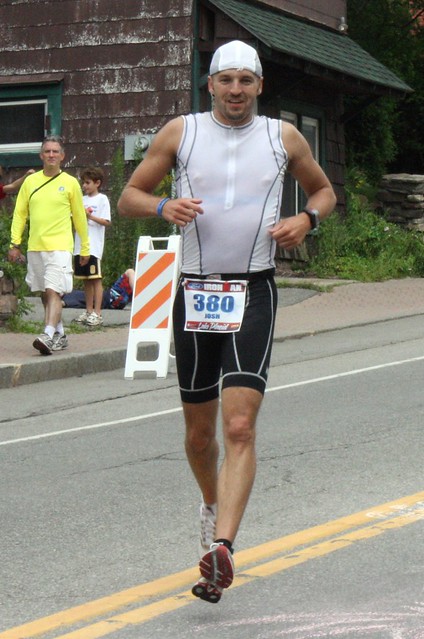 I was expecting to enter an ugly place in the last 10 or so miles of the race. I knew eventually it would start to hurt, and that if it didn’t I wasn’t going hard enough. And I knew that being mentally tough would be the way to keep running. And I knew that not stopping was the real key to having a good ironman run. Almost on cue, my legs began to complain rather loudly at mile 16. It’s not that I was in pain, just that I could feel like something wasn’t right with them. Somewhere during mile 17, I suffered a crippling hamstring cramp that literally stopped me in my tracks. I was doubled over holding them and making caveman noises while people ran past me. I massaged them and stretched them and slowly started back up with an adjusted pace. At the next aid station I walked and gorged myself on crampy foods (sports drink, pretzels, bananas, coke, broth). Things felt better after that… no more cramping but always with that warning feeling – like if my stride was one inch longer I’d cramp again. I was able to keep running though did slow down through some aid stations to get a little extra. I believe I walked through 2 more stations though I’m not positive. On the short but steep hill on 73 I slowed my pace but was able to keep moving. Then going up the hill on Main Street (the final two miles) the hamstring cramp returned. What ensued was the most memorable moment in my own athletic career. I was doubled over in pain holding my hamstrings – just like Norman Stadler in the 2008 world championships if you’ve seen the NBC broadcast. Same posture, same noise/grunt/scream, same stopped in your tracks pain and grimace on your face. Except for me, I was on Main Street in Lake Placid right outside the finish area, and there were literally hundreds of people watching it happen. I remember being so close but also feeling like I just couldn’t take a single step. Several spectators asked if I wanted them to get help (medical). Dozens others started chanting “you can do it” and “almost home” and “walk it off” and other encouragements. I rubbed my legs and tried to stretch a little, and the cramp subsided. I took one baby step forward as they started to cheer and the cramp returned with a vengeance, and I screamed again as stopped and bent over in pain. At this point the crowd went almost silent watching the drama. Someone started the cheering back up again and I soon I could hear a few, then several, then dozens of people chanting a crescendo of encouragements. I repeated the massage stretching routine, and then took one step without a cramp. At my second step what must have been close to a hundred people on either side of the street started screaming and clapping and whistling. By the time I took my third step and was almost jogging it was a deafening roar of cheering all of me, and I was overwhelmed at the entire experience and cried like a baby while I started to run. I took a second to do a fist pump and thank everyone and they went nuts, and I could see on several people’s faces that they were utterly enthralled with what they were watching and were equally moved and emotionally captured by witnessing and participating in my little individual ironman triumph. I hobbled through mile marker 25 and then the leg loosened up on me and the adrenaline kicked in and I was able to cruise home the last mile at my fastest split of the day. People who saw me come in thought I looked great, but anyone on main street knew those last few miles were pretty ugly.
Finish chute: 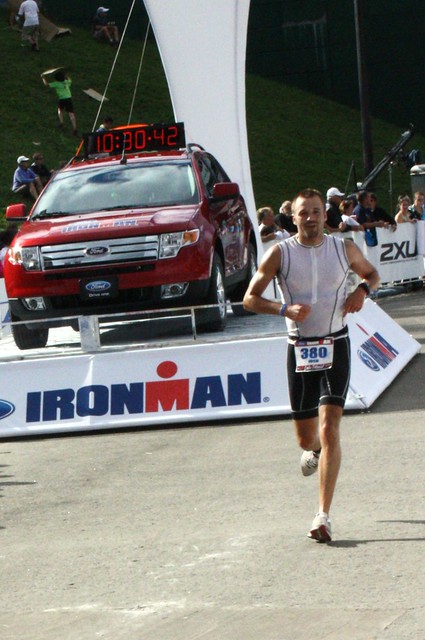 Finish: 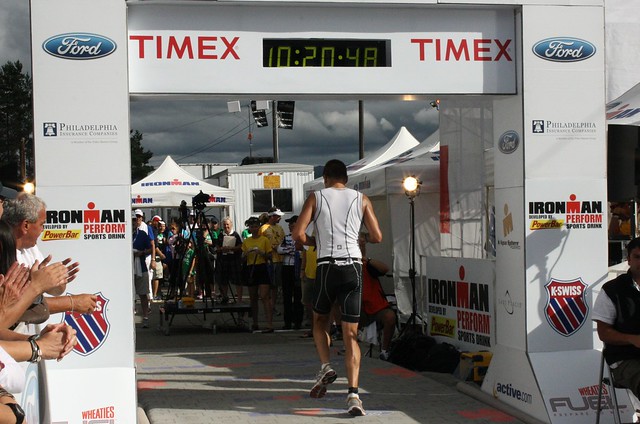 10:20:48 felt really, really good. I knew it meant I had prepared well and executed well, and that I had nothing to regret about the day. When I got into the water in the morning, I told myself I did not care what my finish time was and that I had a million things to be thankful for even if the day did not go well. I think I was blessed to have success beyond what I really thought was possible, and that it was doubly-rewarding to do it with an attitude that there were more important things about my day than what the clock said when I crossed the line. That’s not to say I’m not a competitor, and that it doesn’t hurt to know I was only a few minutes away from a ticket to the big show. 21 minutes would have just gotten me in this year, and would have solidly gotten me in for each of the last several years, in my age group. While 21 minutes seems like an eternity, I can pretty easily see where I could find them. Half of them could come from some serious swim work + the faster transition I could have without the “average swim” crowd in the tent. The other half could be split between only a tiny bit of extra speed on the bike and a cramp-free run. I was up about 7 pounds on race day from my lowest weight, after two weeks of sloppy diet during the taper, which certainly didn’t help. I honestly believe that with a year of work, a slightly lower weight on race day, and some confidence from the experience I now have under my belt, it’s achievable. Now I have to decide if I want it badly enough to do the work required. Team Kaptur: 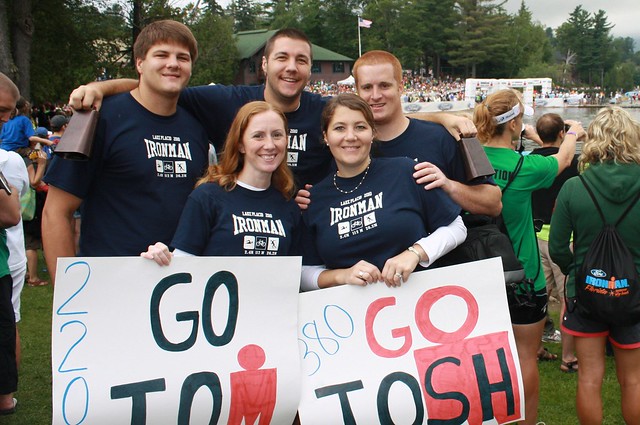 Some much deserved “rest and relaxation” during the recovery… which somehow all seemed to involve physical exertion… Hiking whiteface on Tuesday:  Canoeing/Fishing Lower Saranac on Wednesday in IM finisher's gear: 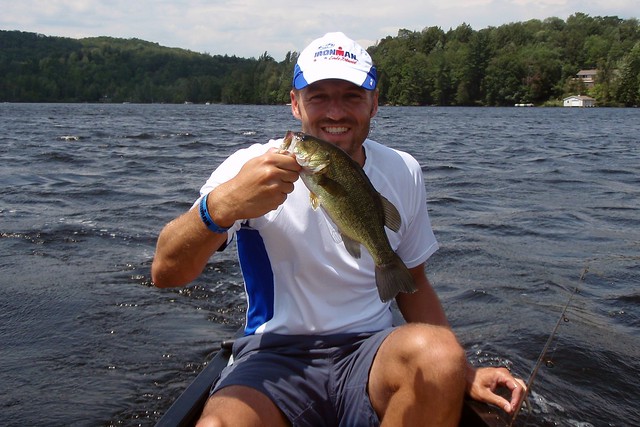 Extra race photos for as long as ASI keeps them up: http://www.asiorders.com/view_user_event.asp?EVENTID=60052&BIB=380 I really like the one where I’m taking the turn in aero, except they cut off my front wheel. Also like the smiling ski jump picture. Haven’t decided yet if I’m going to plunk down the money and order any (I wish I could order the electronic original of just a couple pictures). In the future, I promise to do something better than look at my watch as I cross the line! Last updated: 2009-12-29 12:00 AM
|
|
|||||||||||||||||||||||||||||||||||||||||||||||||||||||||||||||||||||||||||||||||||||||||||||||||||||||||||||||||||||||||||||||||||||||||||||||||||||||||||||||||||||||||||||||||||||||||||||||||||||||||||||||||||||||||||||
United States
Ironman North America
Overall Rank = 120/2611
Age Group = M30-34
Age Group Rank = 24/256